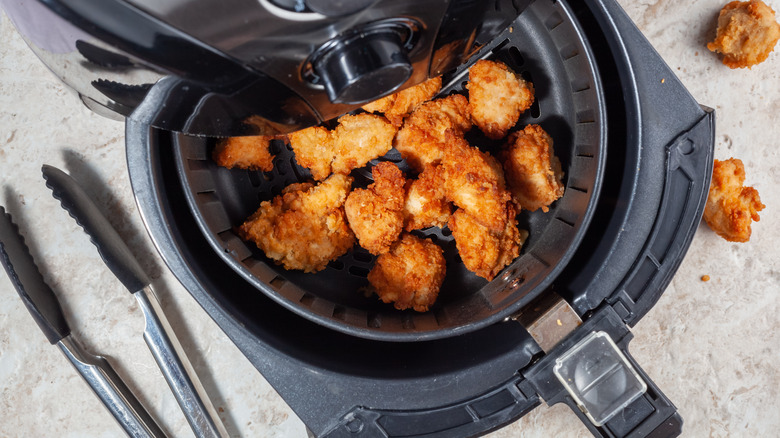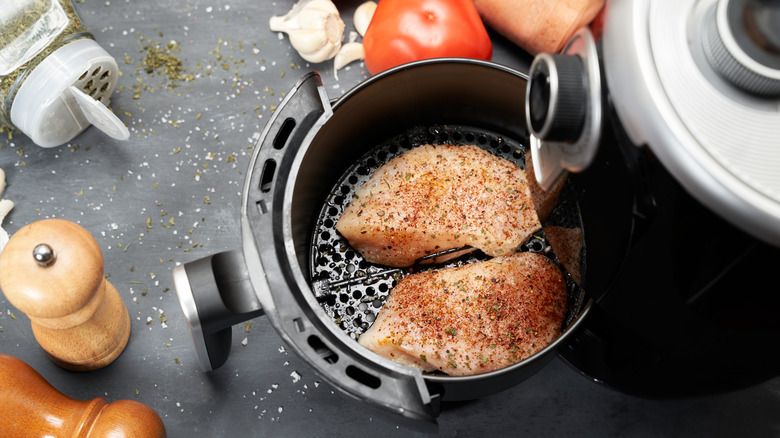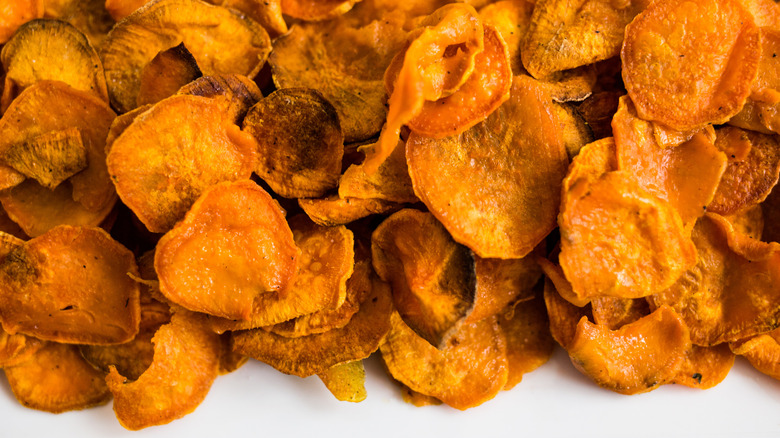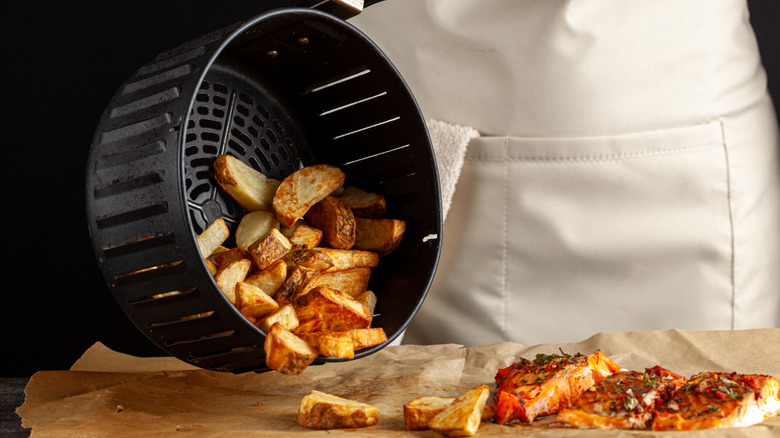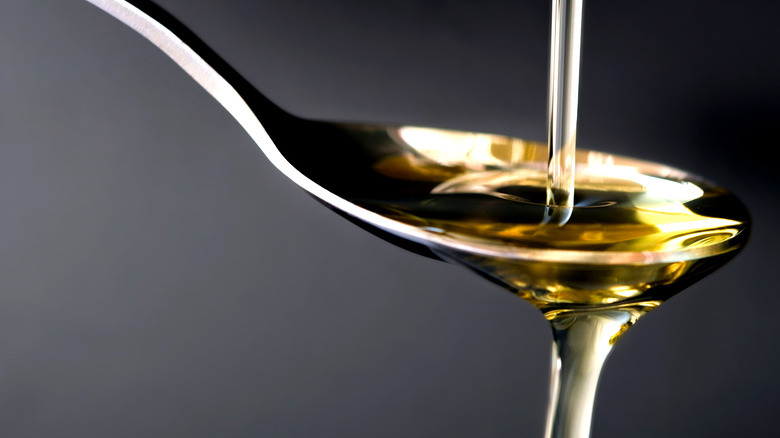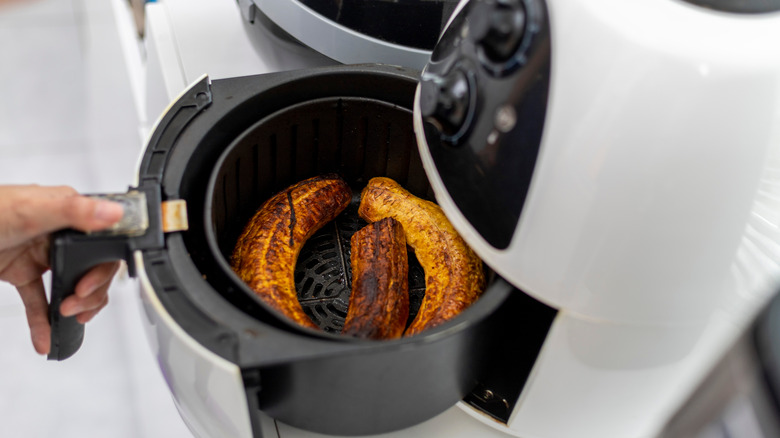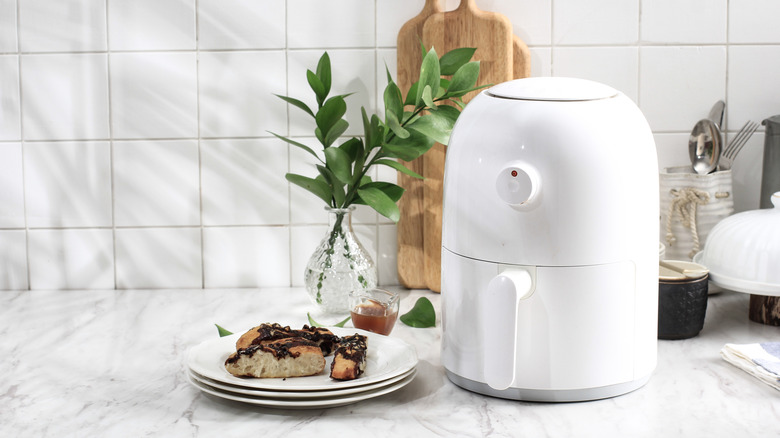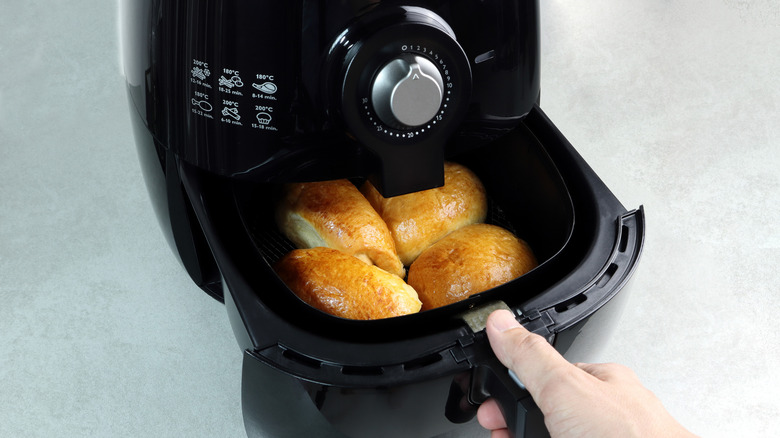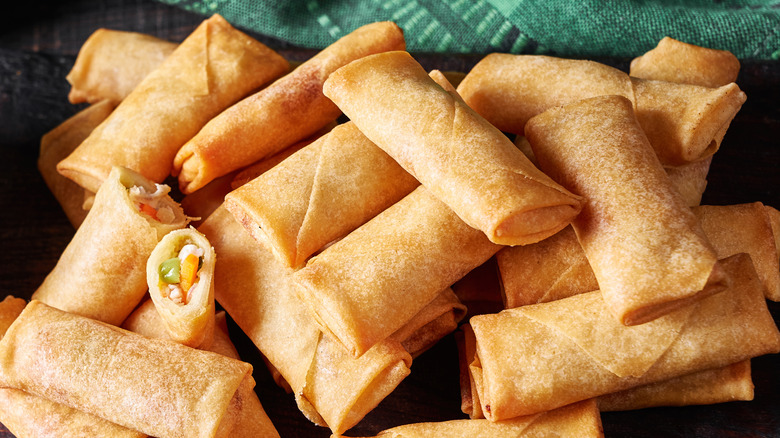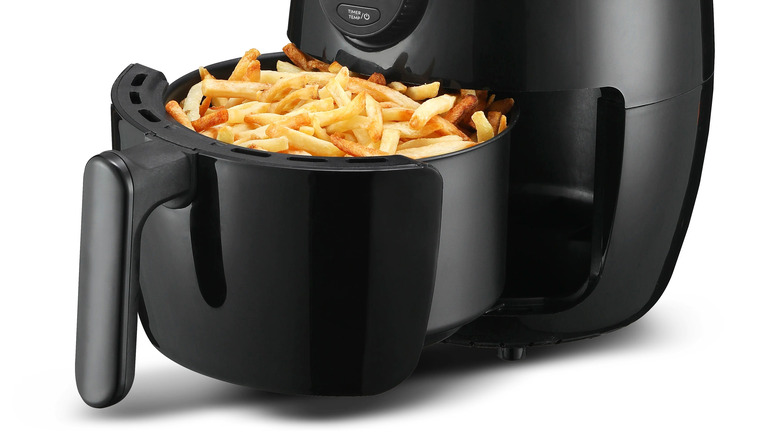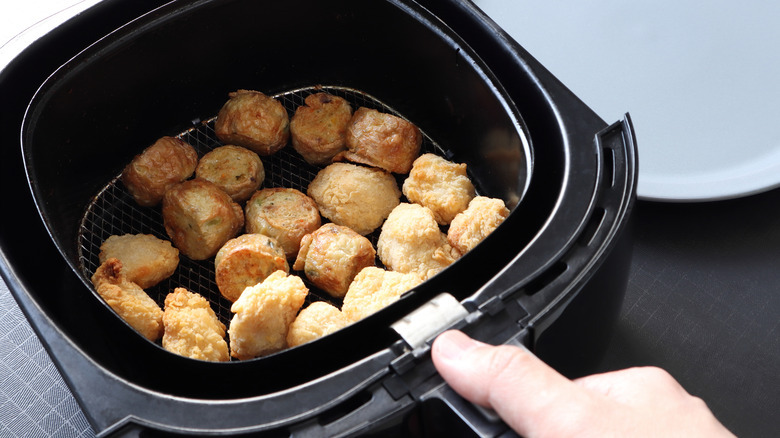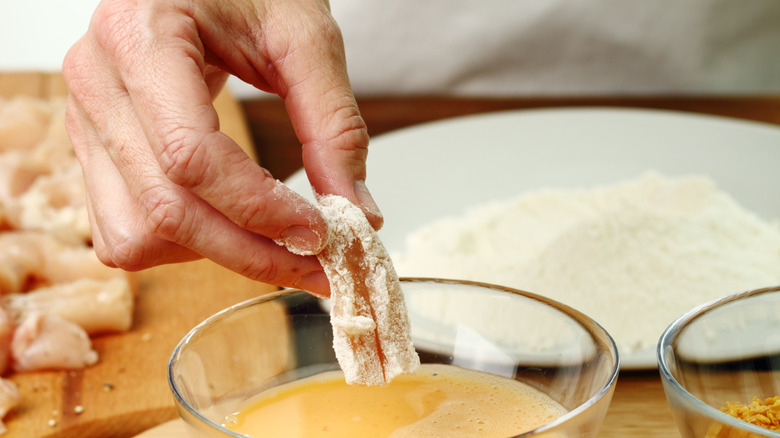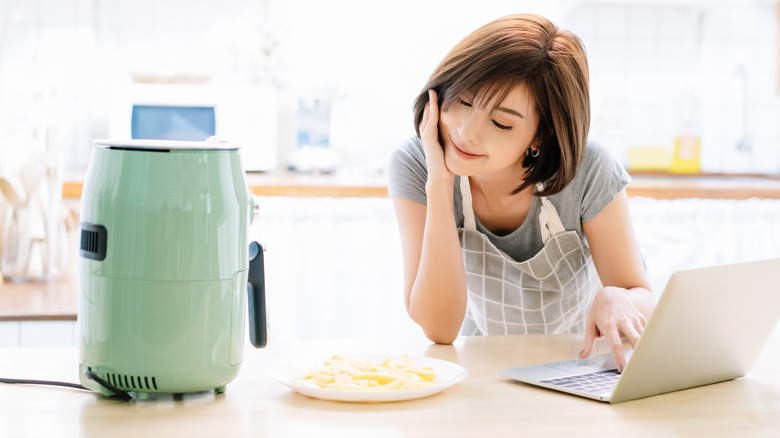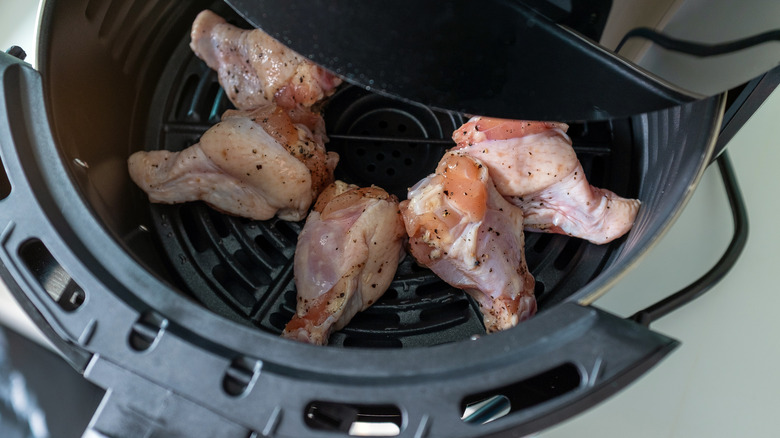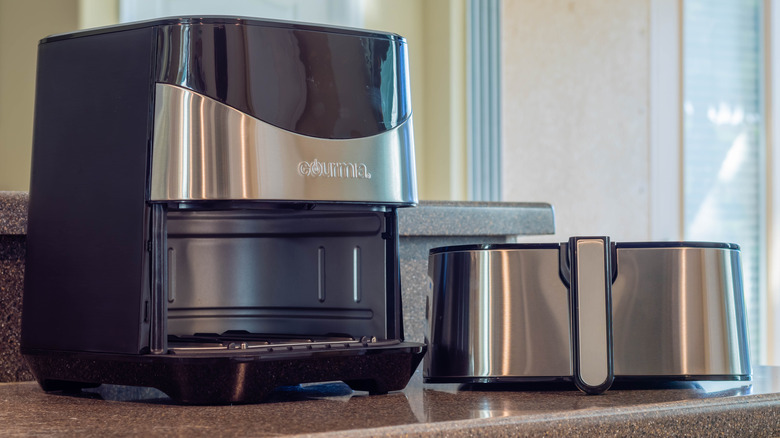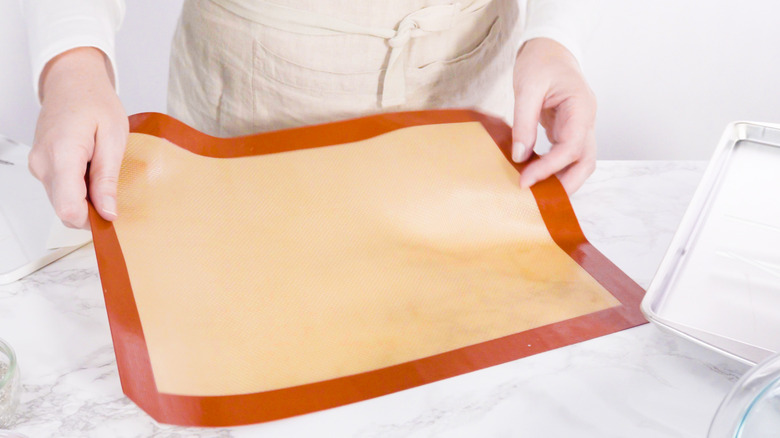The Biggest Mistakes You're Making With Your Air Fryer
The air fryer was supposed to revolutionize the way we cook fried food. No more hazardous pots full of boiling oil. No more questions about what the heck you're supposed to do with all that oil when you're done with it. Most of all, no more greasy, fatty, fried foods. You get all the flavor with none of the guilt. Sounds too good to be true, doesn't it?
As it turns out, it is too good to be true — but only if you're making the mistakes that most people make when they buy an air fryer. Are your fries limp? Did your tortilla chips burn? Did your countertop melt? These are some of the most common problems people have with their air fryers, and they happen not because air fryers don't work as advertised, but because consumers don't yet understand the subtle nuances of these still relatively-new devices.
If this is you, don't worry. There's no need to wonder if the manufacturer will take back your used, maybe not perfectly clean, air fryer. Chances are, there's nothing wrong with it. You're probably not getting the perfectly cooked, low-fat food of your dreams because you're making some of these very common mistakes. Let's take a look at what to avoid.
You're not preheating your fryer
Not all recipes require preheating. In fact, your air fryer's manual may even explicitly state that you don't need to preheat the device, like the manual for the Philips air fryer owned by a reviewer writing for Reviewed. But many home cooks are finding that turning their fryer on for a few minutes before actually using it to cook something means the difference between food that has a blah, oven-fried, kinda-mushy quality and food that is more like something you'd get out of a deep fryer.
Even if the recipe you're using doesn't say you should preheat your fryer, you might want to try doing it anyway, especially if you're consistently getting disappointing results with those recipes. Just be sure to check on your food while it's cooking, since preheating may shorten the cooking time a bit, and you don't want to have the opposite problem of over-crispy (burned) food.
You aren't securing lightweight food
For some people, cooking healthier versions of snacks like chips is a big selling point of the air fryer. But after scraping a few scorched kale chips off the heating element, well, let's just say the honeymoon ends there. The air fryer is a convection device, which means it works by blowing hot air around, per The Spruce Eats. The food sits in a basket that has holes in the bottom so the air can circulate on all sides of your french fries, chicken patties, or whatever. The hot air will color the food and make it crispy if all goes well.
But the keyword here is "air." What happens when you're outside having your lunch on a picnic table, and the wind picks up your sandwich bag? You end up chasing your sandwich bag around the park. The same thing happens in your air fryer. The "wind" blows the light stuff around. At best, you end up with a quesadilla without a top. At worst, you get a batch of scorched kale chips.
Fortunately, the solution to this is pretty simple. Ninja advises air fryer users to secure the light ingredients with a toothpick. This doesn't help much if the problem is kale chips, though. For that problem, food bloggers popularly recommend putting a rack over the chips to keep them in place (via Whole Lotta Yum).
You're skipping the oil
Yes, your air fryer did promise oil-free frying. The reason you bought it was so you could enjoy crispy food without all the fat. But really, the air fryer isn't at its best when you take the oil completely out of the equation. Relax, though, because if you do it right, you're still cutting way, way back on the amount of oil you use. Adding a bit of oil will help your food brown and improve the flavor, too.
Philips says you can use any oil in your air fryer except cold-pressed oil because it has a low smoke point. To cook a batch of fries, you only need about 1.5 teaspoons of oil. Just add it to a bowl and toss your uncooked fries in it, then dump them into the preheated fryer. Alternately, you can just lightly spray the potatoes with a bit of spray oil, toss them, and then add them to the fryer (via Taste of Home). As a bonus, you can season your lightly oiled fries with garlic salt or another favorite spice, and it won't blow around and scorch during cooking.
You're using too much oil
Some home cooks seem to have the opposite problem — they're treating the air fryer like a deep fryer. Let's forget for a moment how little sense this makes, since the central selling point of an air fryer is that you can fry food without all the fat. Still, some people seem to be making this mistake.
So what happens if you use too much oil in your air fryer? Well, for a start, The Washington Post says you'll get soggy food. This is the opposite of what you want, since the whole point of frying anything, no matter what technique you use, is that the result will be crispy.
But that's not even the worst thing that can happen. Food that's overloaded with oil will drip, and when the oil leaks, it ends up under the basket on the hot bottom of the fryer. When this happens, the fryer will smoke and may even overheat (via Kitchen Appliance HQ). So the best thing that can happen is you'll get food that's soggy and less healthy than it should be, and the worst thing that can happen is you'll wreck your not-so-cheap machine.
You aren't checking on the food
In today's world, convenience rules. Who wants to stand in the kitchen all evening when you can doom scroll Twitter or binge-watch all 16 episodes of "The Witcher"? There are much more important things in life than making sure dinner tastes good.
Unfortunately, if you're one of those people who wants to get the best possible result from your air fryer, you will have to put down your phone for a few seconds or step away from the television. All air fryers are a little different, and just because a recipe says it will take 15 minutes at 400 degrees doesn't necessarily mean that you can just hit start, walk away, and trust that your food will be perfect when the bell rings.
According to TV chef Meredith Laurence, one of the great advantages of the air fryer is that you can open it up, check on its progress, and close it back up again if the food doesn't look ready. And, you can do this as often as you need to — opening the fryer doesn't interrupt or slow down the cooking process. The visual feedback is pretty simple to read, too. If it's golden, it's done. If it's not, give it a few more minutes. (An obvious exception: chicken and other meats. Always check the internal temperature of the meat before deeming it "done.")
Your air fryer is the wrong size
Air fryers aren't really a budget-friendly appliance. You may find yourself wondering if you can get away with buying a smaller cooker, because the 4-quart one is half the price of the 8-quart one. If you make this decision based on price alone, you may end up regretting your purchase. According to Taste of Home, a 2-quart air fryer is only suitable for someone who cooks for themselves and maybe one other person, provided you're both light eaters. If you frequently cook for yourself and one or two other people, you might be able to get away with a 3-quart cooker, but a 4-quart model will be a lot more versatile.
If you have a family of four, go for a 6-quart model. If you have a large family or you like to host dinner parties, you may need an extra-large model with something like an 8-quart capacity. So what if you get something a little too small — can't you cook in batches? Sure, you can, but you're going to regret this when you're on your fourth batch of fries, and the first batch is already getting cold. It may seem like a good money saving-idea now, but in the long run, you're probably going to decide that using your air fryer is too much hassle, and then you might as well have not spent the money at all.
You're not taking advantage of its full potential
You probably bought your air fryer so you could make low-fat French fries and chicken strips. You're not alone — that's like 99% of the reason why most people get an air fryer. But if you're only doing pseudo-fried foods in your air fryer, you're not using it to its fullest potential. Air fryers can also do vegetables, and they can reheat fried foods back to the point of crispiness (even leftover French fries from your local burger joint, per Taste of Home). And according to Hamilton Beach, you can also bake and roast in an air fryer.
In fact, if your basket is big enough (or your chicken is small enough) you can even do a whole roast chicken in the air fryer. Just brush your bird with a bit of oil, add seasoning, and roast until the thickest part of the thigh reads 175 degrees.
Why bake in an air fryer? Well, maybe it's August and a million degrees in your house, but you'd like some freshly baked chocolate chip cookies. Your air fryer lets you bake a quick batch without waiting for the oven to warm up and/or adding more unwanted heat to your kitchen.
You're thawing frozen foods before cooking
If you want French fries but would rather not slice them up yourself, you can just cook a batch of frozen fries in the air fryer. It's quick and easy, and you also get that nice crispy fried texture that you can't really duplicate when you do them in the oven. According to Taste of Home, you can buy packaged, frozen foods like chicken tenders and egg rolls and just put them straight into the air fryer, with perfectly crisp results. Don't thaw these products first. If you do, you're just wasting your time and may even end up with poorer quality food.
Taste of Home even recommends cooking frozen salmon filets in your air fryer, straight from the freezer, though other sources beg to differ. Pretty much everyone — including the USDA — agrees that it's safe to cook frozen fish and meat, as long as you're very sure it's done when you take it out of the fryer. You can use an internal thermometer to check. The problem is really quality. Raw meat cooked from frozen tends to be soggy and has less flavor than meat that's been thawed first, so it's probably worth the extra step to put it in the fridge the day before you plan to cook it (via Bon Appétit).
You're overfilling the basket
The key to good air fried food is to make sure that the air can circulate around it. This makes it a bit fiddly to cook large portions of anything because when you stack your food in layers, the air doesn't do its thing, and you end up with some crispy bits and some undercooked pieces.
According to the University of Nebraska-Lincoln, overfilling the basket is a problem for several reasons. The absence of that coveted golden-brown color is only one of them. The larger problem occurs when you're cooking something like a stack of homemade chicken tenders. You might look in the basket, see the crispy brown color on the top layer, and fail to recognize that the tenders in the middle of the stack aren't cooked all the way through. Overfilling the basket can keep everything from cooking evenly, which means whoever gets the tenders in the middle could end up with an undercooked surprise. Raw juices could also drip down through the layers, especially if you shake the basket and dump everything onto the same serving plate. So if you have a lot of people to feed, it behooves you to cook all your raw meats in batches and use an internal thermometer to make sure you won't be poisoning any of your guests.
You're not turning the food or shaking the basket
The good news is, you don't have to put your French fries in a single layer on the bottom of the basket. Overfilling doesn't necessarily mean you can't have pieces of food touching other pieces of food. According to Ninja, it's fine to put a pile of fries into their air fryer's basket. The key is to make sure to shake the basket periodically during cooking, so all or at least most of the fries get good contact with the circulating air.
It's still important not to overload the basket — if there are too many fries, no amount of shaking will make them all crispy. And even when you have things you're cooking in one layer, like a row of chicken strips, you still need to open up the basket halfway through the cooking process to flip them over (via Cook's Illustrated). This helps them cook evenly and ensures a uniform golden color on all sides.
You're trying to cook wet food
If your favorite deep-fried food is beer-battered fish sticks, you can safely exclude the air fryer as a way to make that particular indulgence. You can't do beer-battered anything in an air fryer.
According to Today, beer batters and other wet coatings don't work in an air fryer because they stick to the basket and drip through the holes in the bottom. This creates a huge mess, which isn't fun to deal with when the party's over. Even if you don't mind the extra mess or plan to leave it until your roommate finally gives in and cleans it for you, you're still not going to be happy with your beer-battered fish sticks. That's because wet batters don't crisp up in an air fryer the way dredged and breaded coatings do. They turn out soft and chewy, which probably isn't how you like your beer-battered fish sticks.
You don't know your model's features and quirks
All air fryers are not created equal, so cooking with one is a little trickier than cooking with a standard oven. As long as your oven is performing correctly, for example, you can be pretty sure it will take 12 minutes to bake a batch of cookies at 350 degrees if that's how long the recipe says it will take.
With an air fryer, though, it's different. The most important thing you can do when you first take your air fryer out of the packaging is read the manual. According to Livestrong, not every air fryer recommends the same cooking times for the same types of food. This is because every manufacturer designs their fryer differently, so what takes 12 minutes in one fryer might take 15 in another.
And don't forget that some fryers have bells and whistles that you might miss out on if you don't thoroughly educate yourself about what they can do. Some models, for example, have a two-basket system that lets you cook two different foods simultaneously. Others have separate bake, roast, and fry settings. So if you don't understand all the quirks of your model, you may not be taking full advantage of all the things it can do.
You're not adapting recipes for the air fryer
You probably bought an air fryer recipe book to go along with your air fryer, and that's a great way to get started. Those recipes have all been tested for use in an air fryer, and while you're still learning all the tricks and techniques of good air frying, you probably want to practice tried and true recipes. But there will come a time when you'd like to branch out and try new things, and you can do that without going out and buying another air frying cookbook.
According to Food Network, it's easy to convert many of your deep-frying recipes for the air fryer. First, choose a breaded recipe rather than battered (you already knew that) and subtract 25 degrees from the cooking temperature. Then use the rest of what you know about air frying — add a little spray oil, shake the basket a few times, and cook in small batches. You don't need an air fryer cookbook to tell you all that; it works just the same for any recipe.
You're not leaving enough space around the outside of your fryer
Finally, we need to talk about safety. You may have heard that air fryers sometimes catch on fire or even explode. Thankfully, there aren't a lot of recorded incidents of this kind of thing happening. But according to New York Post, in the fall of 2021, a college student's air fryer exploded because she left it on her stove and accidentally turned the burner on, so we're going to say that wasn't the manufacturer's fault. In fact, Consumer Alert Now says most air fryer fires and explosions happen because of improper use, including adding too much oil or other mistakes like submerging the fryer in water to wash it.
According to Air Fryer World, you can't be too cautious with your air fryer. Make sure you pull it away from the wall while in use and leave plenty of space on all four sides for the air to circulate. If you're going to use parchment paper inside of it, make sure there's plenty of weight on top of it. If the paper isn't weighted down, it could blow around, meet the heating element, and catch fire.
You didn't protect your countertops
One final thing to watch out for may not be something you immediately thought about. After all, the air fryer is designed to be a countertop appliance, so why would it occur to you to protect your countertop from it?
Well, according to Air Fryer World, some air fryers do get hot enough on the outside that they can damage your countertop or any nearby appliances. One writer at Today recalled melting his coffee machine when he put his new air fryer too close to it. After receiving too many distressed messages about damaged countertops, the blogger at Fork to Spoon begged her readers to put something heat-safe under their air fryers. Silicone pastry mats, ceramic tiles, and counter mats designed to receive hot pans and pots will all work to protect your countertops and give you peace of mind. Most importantly, though, don't leave your air fryer unattended and unplug it when you're not using it. These very simple safety tips will help you get the most out of your fryer while also, you know, not burning down your house.
